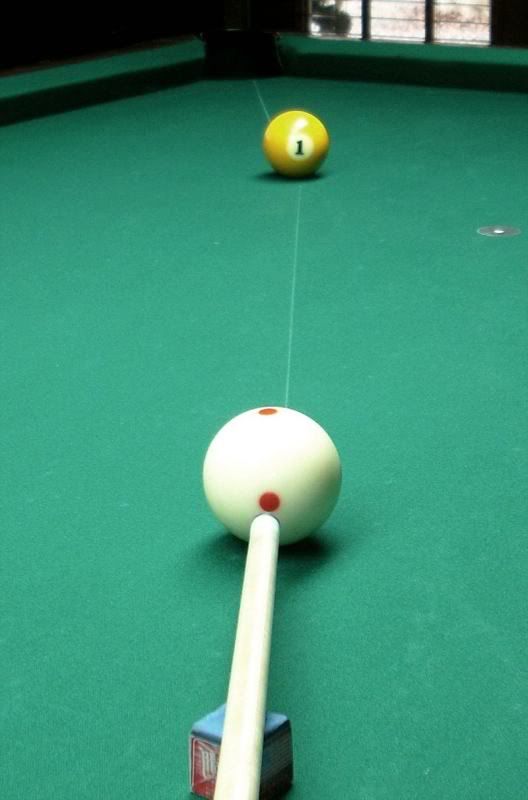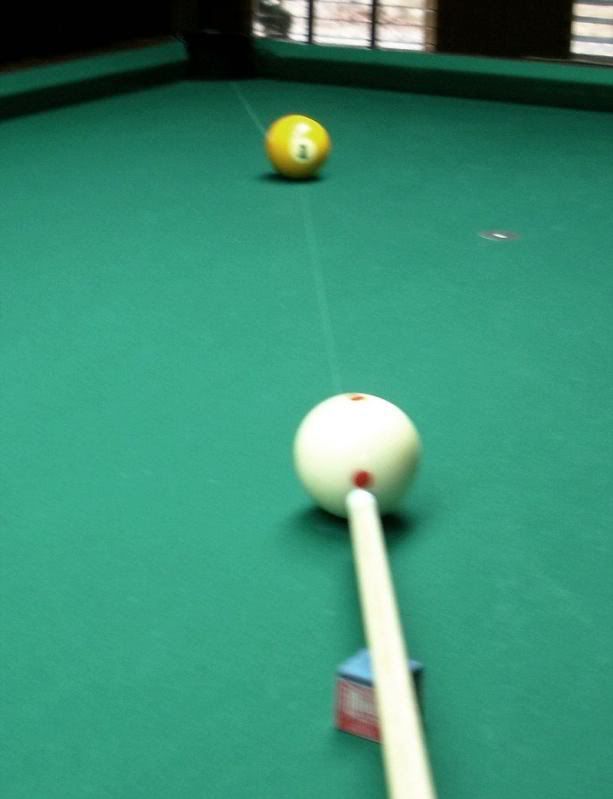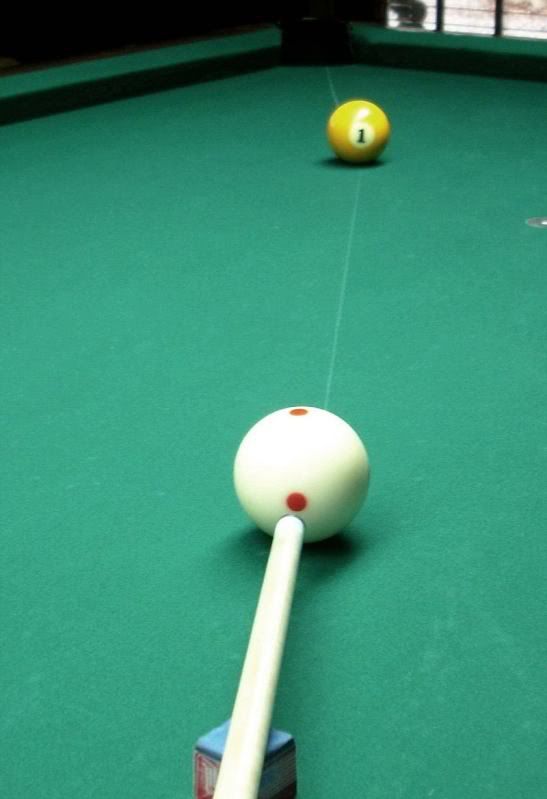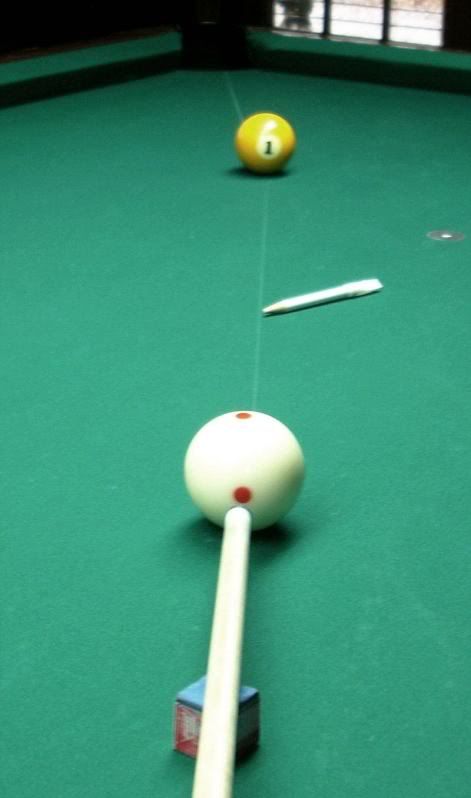This is just my opinion but.............
************
Could you please provide some expansion on using facial landmarks.
*************
Basically, he recommends lining up two or three points on a vertical (saggital) plane of the face to eliminate unwanted head tilt.
Example: Someone who wants to position center of head directly over cue would align both chin and point of nose over cue, as using just the chin as a landmark could be done with substantial head tilt.
Someone shooting like Ralf might use their canine teeth aligned with the cue, particular point on the jawbone, ect.
Hi there Dead Crab,
From what I have found when I have found someone with a head tilt of twist, trying to change this is usually more trouble than solution.
The tilt or twist of the head can actually enhance the aim by making the middle smaller. Even though this is a small thing it can help.
You can realistically compare this to a baseball player at the plate. When you are standing sideways and looking at the batter you don't have your head turned all the way so your face is turned all the way flush towards the pitcher. In fact pretty much everyone has their head positioned so it appears they are kind of peeking with the eye that is closest to the pitcher. They are looking with both eyes even though one is closer and one is a little farther away.
Some experts claim that it is an advantage to be opposite eye dominent because the dominent eye is actually closer to the pitcher and gets the info quicker than if the other eye was dominent because it is farther away.
Do this for yourself and you will be able to see that head tilt or twist has very little to do with how you see the shot.
Look at an object or at the tv and have your head facing perfectly. It looks pretty good. Now turn your head to the right a little and then do it alot. It still looks good. Think about it? Common sense and seeing this little example for yourself should tell you that your head tilted does not effect the way you see the image unless you almost get upside down which would be kind of hard.
The eyes are amazing tools. They adapt to many things. This is not one of the problems with aiming but from what I have seen with many lessons is better off left alone. Especially when the physical limitations won't allow the head to be straight. You can wreck a guys game if he really takes to heart that his head has to be straight.
This is where I go back to the middle. The more the head is tilted the smaller this middle is. I really don't know if this helps with the aiming but it definitely doesn't hurt unless it could be extreme where you are almost lying down on the table but it does make the middle smaller.
In this middle there is only one spot on every shot that is perfect. By making this middle smaller it could be an advantage because the smaller the middle the less you could be off on the shot.
But when everything considered, if your eyes are only 1/8 of an inch off from this perfect spot the shot is not being aimed as good as it possibly could be. We need to have the aim as perfect as possible because there are so many other thing other than aiming that can effect the outcome of the shot.
Bottom line though, if you don't have it aimed perfect nothing will work. Because after the bad aim everything else that your are trying to do just snowballs into a bid disaster on that peticular shot.
If you have the eyes off and it doesn't look right it probably has no chance right from the start to go. Now add something not quite right with the stance. Guess what? Your eyes tell you where to set your stance. Now lets put a little glitch in the stroke. Now lets add a little english to the ball. Add some squirt, a little deflection, a little jumping up because the shot really didn't look right from the start and it's amazing that sometimes this shot will go anyway. Almost a miracle.
It all starts with the aim and the eyes. The eyes are the starting point. This is what sets up the shot ,the shape, the stance, the everything.
Understanding this middle is a vital part of Perfect Aim. This will help you find your dominent eye when it seems like you don't have one, it is very important in knowing where to position the head and eyes on every shot. The dominent eye tells you where this perfect spot is in this middle because it runs the whole show as far as aiming a pool shot.
The reason some players aim so bad is because they are way off as far as having the eyes in the right spot of this middle. Alot of the better players just have trouble on certain shots as far as being in the right spot of the middle. On a scale from 3 to 10 as far as aiming ability it would directly cooralate with how far they are off this spot and on how many shots they are off on.
Many players are in the wrong spot on the same shot all the time and continue to be in the wrong spot and miss that peticular shot almost all the time because they don't have the ability to identify the problem so therefor that makes it impossible to correct.
Anyone that wants to sincerely improve their game needs to learn Perfect Aim. Not just buy one and look at it and stick it in a drawer. Or watch it once or twice and write a mock review telling the world how much they don't understand it.
You need to sincerely want to learn and try to apply it to your game. You need to get on the table and dig a little bit and try to see what happens when you see what you can see if you know what to look for.
If Perfect Aim was so easy to understand somebody would have been teaching it before myself. Many people over the years have learned certain parts to this puzzle but they are just parts. What good is a puzzle unless you have every piece. Even if you are missing a couple of pieces you can still see the picture that the puzzle is trying to portray.
This is why I offer the service to everyone that has purchased Perfect Aim and make my personal cell phone number available so they can ask me questions personally about Perfect Aim. I know that everyone will not just get it right away. In fact my personal lesson can last anywhere from an hour to 4 hours. There are just a few players that need a little more TLC brfore it clicks but once it clicks they got it.
So please call 715-563-8712.
I know this got a little off the topic of the middle but I hope if anyone that does need help will call. Usually it is just a very simple thing that makes the light go on and your on your way.
Thanks for your input, Have a great day Geno..............



